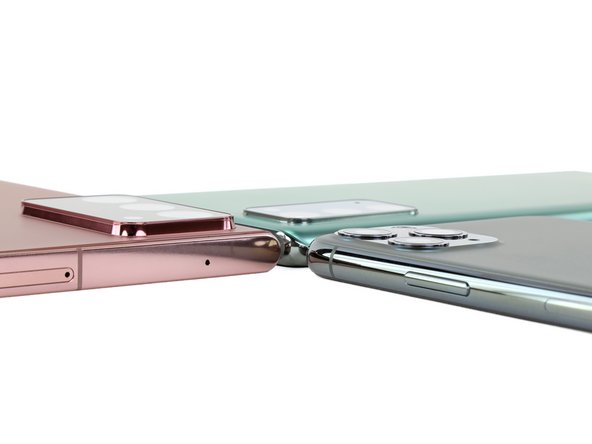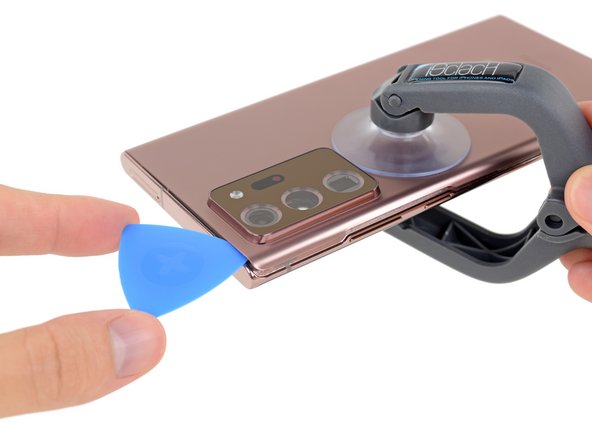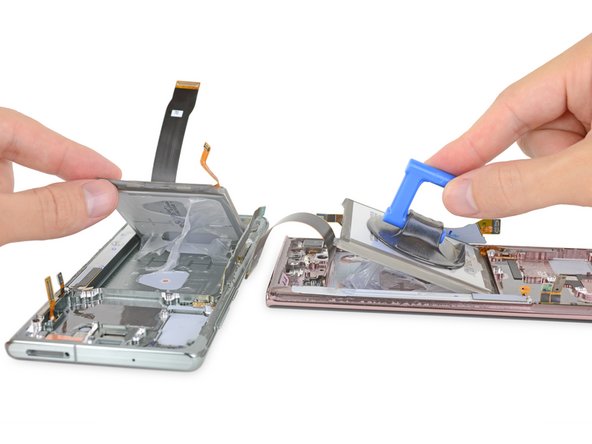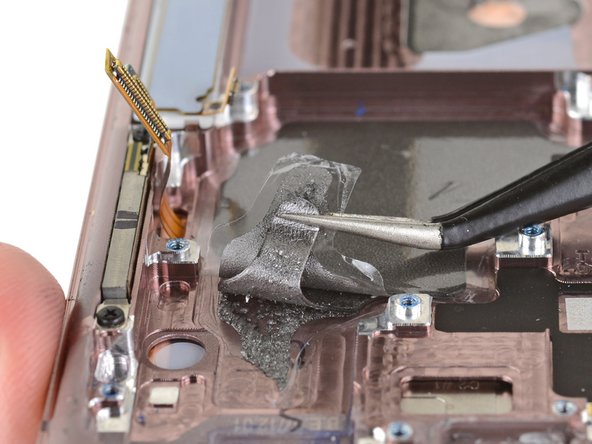Samsung Galaxy Note20 Ultra Repair Guide: Step-by-Step DIY Tutorial
Duration: 45 minutes
Steps: 13 Steps
We’re diving into the latest Samsung Galaxy gadgets from Unpacked this month. First up, we’ve already dissected the Beans and the Watch, and now it’s time for the Galaxy Note 20 and 20 Ultra. We’re doing a side-by-side teardown, so grab your S-Pen and let’s get down to business. Follow along as we explore these devices inside and out. For more teardowns, you can always stay connected with us on Twitter, Instagram, and Facebook. And if you need some hands-on help, feel free to schedule a repair.
Step 1
– There are a bunch of different versions out there, but we picked the US models with 5G mmWave for this teardown—so you’re getting the full scoop.
– Let’s kick things off by taking an X-ray peek inside the Ultra (thanks to the wizards at Creative Electron for the cool images).
– Both devices sport Snapdragon 865+ processors: 8 GB of LPDDR5 RAM in the Note 20, and a beefy 12 GB in the Ultra.
– The displays? Infinity-O AMOLED all the way—6.7″ (2400 × 1080) on the Note 20, and a massive 6.9″ (3088 × 1440) on the Ultra, with a buttery 120 Hz refresh rate.
– You’ll get 128 GB of built-in storage, and the Ultra lets you tack on up to an extra 1 TB with a microSD card.
– Each phone has four cameras: a 10 MP selfie, a 12 MP ultra-wide, and the Note 20 gets a 12 MP wide-angle plus a 64 MP telephoto. The Ultra kicks it up with a 108 MP wide-angle and a 12 MP periscope telephoto featuring 5x optical zoom.
– Battery life is solid too: 4300 mAh in the Note 20, and 4500 mAh in the Ultra.
– Connectivity is future-proofed with 5G, Ultra Wide Band, 4×4 MIMO LTE, Wi-Fi 6 (802.11ax), and Bluetooth 5.0.
Step 2
Now that the two devices are sitting side-by-side in the X-ray cabinet, we’ve got some interesting clues to look at.
– Let’s talk about some colorful details! We chose Mystic Green for the Note 20 and Mystic Bronze for the Ultra—because Mystic Blue and Black weren’t available options. Ever wonder why the wireless charging coils—those neat concentric rings in the middle—look so different? Samsung hasn’t revealed big specs changes, but the Ultra sports a double-coil setup that’s pretty interesting. And check out the Ultra’s camera bump—it’s huge! The 108 MP sensor in the center is already massive, especially with the sliding periscope module right next to it. It’s reminiscent of what we saw in the S20 Ultra. If you need help with any of these steps, you can always schedule a repair to get professional assistance.
Step 3
– Let’s kick things off by grabbing our S Pens and sketching out some thoughts on camera bumps. If you’re a fan of glass-on-glass action, the Galaxy Note 20 Ultra’s got you covered.
– That triple-lens setup on the iPhone 11 Pro Max suddenly seems pretty subtle by comparison. Guess we owe it an apology for all the grumbling.
– Some phone makers are pulling off impressive camera results with smarter software, while Samsung’s gone all-in on the hardware route. We’re curious to see what the next round of phones will bring!
While smartphone parts keep getting smaller and better over time, camera tech tends to go the other way—mainly because capturing sharper, more detailed images usually needs bigger sensors and more lenses. So, don’t be surprised if your phone’s camera is a bit stubborn when trying to slim down without sacrificing quality. If you need help, you can always schedule a repair.
Step 4
If you’re reaching for the heat gun, double-check those settings! Glass can handle some serious heat, but this plastic is more of a softie—it’ll start to droop or warp if things get too toasty.
– Alright, let’s get down to business. Our iOpener was nearly no match for the heatwave out here on the west coast—we probably could’ve just let the phones sit outside for a bit and the adhesive would’ve softened on its own.
– Next up, a little careful iSclack and opening pick action—both back covers come off smoothly, no surprises. We’re officially in teardown mode.
– The adhesive is still stubborn, but with the plastic back on the base Note 20, things feel a bit more forgiving—it’s more flexible and less likely to crack under pressure.
– You can argue in the comments whether a $1,000 phone should have a plastic back, but from a repair standpoint, it’s probably a win overall.
Step 5
Galaxy phones might not win any awards for being the easiest to repair, but they do get a solid gold star for using standard Phillips #00 screws. It’s one less thing to worry about!
– Just like old times—the first thing to tackle inside are those trusty screws. Grab your toolkit and let’s send them packing.
– After wrestling with a few stubborn midframe screws, we finally get a solid peek inside (at least with regular old eyesight).
– Each phone’s earpiece speaker is tucked into the upper antenna assembly, surrounded by its own shiny enclosure—pretty cool! The speaker’s the rectangle outlined by a bright red gasket. It still channels sound through the midframe, similar to the Note10 and S20, but these bigger enclosures should give your tunes a little more oomph.
– Both models have a rear mic hanging out on the back cover, and it connects with handy spring contacts. Good news: no sneaky surprises or hidden traps during the opening process.
Step 6
These two camera setups mainly differ in their zoom capabilities and the number of pixels they pack inside. One’s zoom game is a bit stronger, and the other has a sharper focus with more pixels. Simple as that!
– Let’s move on to the cameras. To access them, you’ll need to remove both motherboards first. Keep in mind, neither Note model features the S20 Ultra’s 40 MP front camera—both have 10 MP selfie sensors, which can sometimes give a softer look. Interestingly, the standard Note 20’s selfie module is easier to pry out, while the Ultra’s is firmly glued in place. The Ultra borrows the impressive optical Space Zoom module from the S20 Ultra, but with a smaller 12 MP sensor behind it. For a detailed look at the periscope mechanism, check out the link. The regular Note 20 relies on a 64 MP sensor with some clever cropping rather than space zoom. When it comes to wide-angle shots, the Ultra boasts a massive 108 MP sensor (which typically bins down to 12 MP), whereas the regular Note has a more modest 12 MP sensor here. If you need help with any step, you can always schedule a repair.
Step 7
– Big thanks to Samsung for making these motherboards look like AT-ATs! We’re ready for a Hoth showdown any time now. Let’s see what’s packed inside these bad boys:
– Snapdragon 865+ under a blanket of Samsung LPDDR5 RAM – a power combo.
– Samsung KLUDG4UHDB 128 GB universal flash storage – storing all your data in style.
– Qualcomm SDX55M 5G modem-RF system and SMR526 intermediate frequency IC – for that next-level 5G connection.
– Qualcomm QDM4820, QDM5872, and QDM4870 FEMs – making sure your signals stay strong and clear.
– NXP 11OUV2H and 9468B3 – probably part of NXP’s cutting-edge solution to combine UWB fine-ranging, NFC, Secure Element, and embedded SIM.
– Maxim MAX77705C PMIC – keeping everything powered and running smoothly.
– Possibly ON Semiconductor FPF3788UCX OVP load switch – making sure everything’s safe and sound.
Step 8
– The components listed are key parts inside your device, each playing a vital role. The Qualcomm SDR865 5G and LTE transceiver handles your network connections, while the likely Wacom W9020 digitizer controller makes the touchscreen responsive. The Murata 1RH WiFi + Bluetooth module keeps you connected wirelessly. The Skyworks SKY77365 power amplifier boosts signal strength, and the Qualcomm power management ICs (PMX55, PM150C, PM8250) help regulate power to keep everything running smoothly. AVAGO AFEM-9136 front-end modules optimize signal reception, and the Qualcomm QPA5580 power amplifier enhances overall performance. If you run into trouble during any step, remember you can always schedule a repair with Salvation Repair for expert help.
Step 9
– Removing a glued-down Note battery can be tricky, especially if there are two of them at once. Luckily, with some adhesive remover, patience, and a little help from suction cups, you can safely detach both batteries without too much trouble. Keep in mind the batteries in the Note 20 and Note 20 Ultra pack a punch with 16.69 and 17.46 watt-hours respectively—more than the iPhone 11 Pro Max’s 15.04 Wh but not quite as hefty as the S20 Ultra’s 19.30 Wh, which has a bigger battery to make room for. Samsung seems to glue their batteries in pretty tightly, but that doesn’t mean there’s no hope. If you need help with this process, you can always schedule a repair for expert assistance.
Step 10
– Here’s a curveball: what’s under the motherboard is not what you’d expect.
– Usually, you’d find a hefty copper vapor chamber soaking up heat from the octa-core processor—Samsung made a big deal out of those in the past. But here? It’s a multi-layered graphite thermal pad instead.
– And the plot thickens—some other Note 20s do have copper heat pipes, just not this US model. Maybe the Exynos chip in international versions handles heat differently than the Snapdragon chip here?
– Other sources report their international models also use graphite, so the mystery continues.
– Could it be related to the 5G mmWave hardware, since not all Notes come with it? Doesn’t add up. Maybe Samsung’s testing new cooling solutions? If you’ve got theories, let’s hear them.
– Both phones in this teardown have mmWave modules—just two each, while older models like the Note10+ 5G and S20 Ultra had three. Maybe the tech got better, or maybe something else is going on.
– Update: We dug up more about these cooling systems and even scored some inside info on Samsung’s design choices. Check it out!
Step 11
– The last components to come out are the two AMOLED displays, which are nestled inside their metallic homes. Behind them, you’ll find some of that copper we’ve been talking about! Samsung has been using copper to help spread heat across their displays for a while now—and that continues here, even with the switch to the graphite layer beneath the motherboard. These phones share the code name Canvas — not quite as clever as last year’s Davinci, but still pretty fitting. On the back of each display, there’s an integrated ultrasonic fingerprint sensor, while the front is protected by Corning’s latest Gorilla Glass Victus, promising a major boost in drop and scratch resistance for the first time in the Gorilla Glass lineup.
Modern smartphone glass has gotten tougher against shattering, but that often means it’s more prone to scratches. So, will this new formula scratch at a level 6 and leave deeper grooves at level 7? It’s a bit of a trade-off—more resistant to breaking, but potentially more vulnerable to scratches. Keep that in mind as you go about your repair. If you need help, you can always schedule a repair.
Step 12
– Almost there! Take a peek at the Ultra soaking up X-rays from every direction—it’s basically glowing with curiosity.
– One puzzle we couldn’t solve: where are those Ultra Wide Band antennas we spotted in the iPhone 11 series? Did we overlook them, or did Samsung go for a totally new approach?
Step 13
– And that’s a wrap! Before calling it a day, let’s crown our champion in the livestream contest—we asked for your most creative reason why Samsung jumped from Note 10 to Note 20, and you delivered plenty of fun ideas. As a parting note, here’s our repairability score—a solid point to end on, don’t you think? Remember, if you ever need a hand with repairs, you can always schedule a repair. Keep your devices in top shape and stay tuned for more repair tips from Salvation Repair!
Success!































